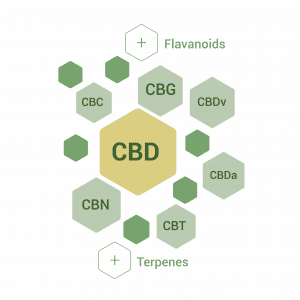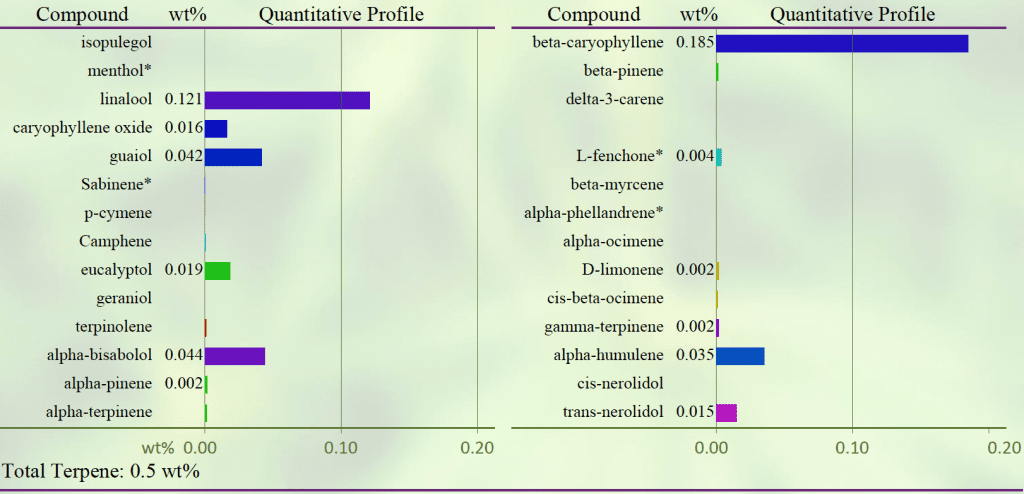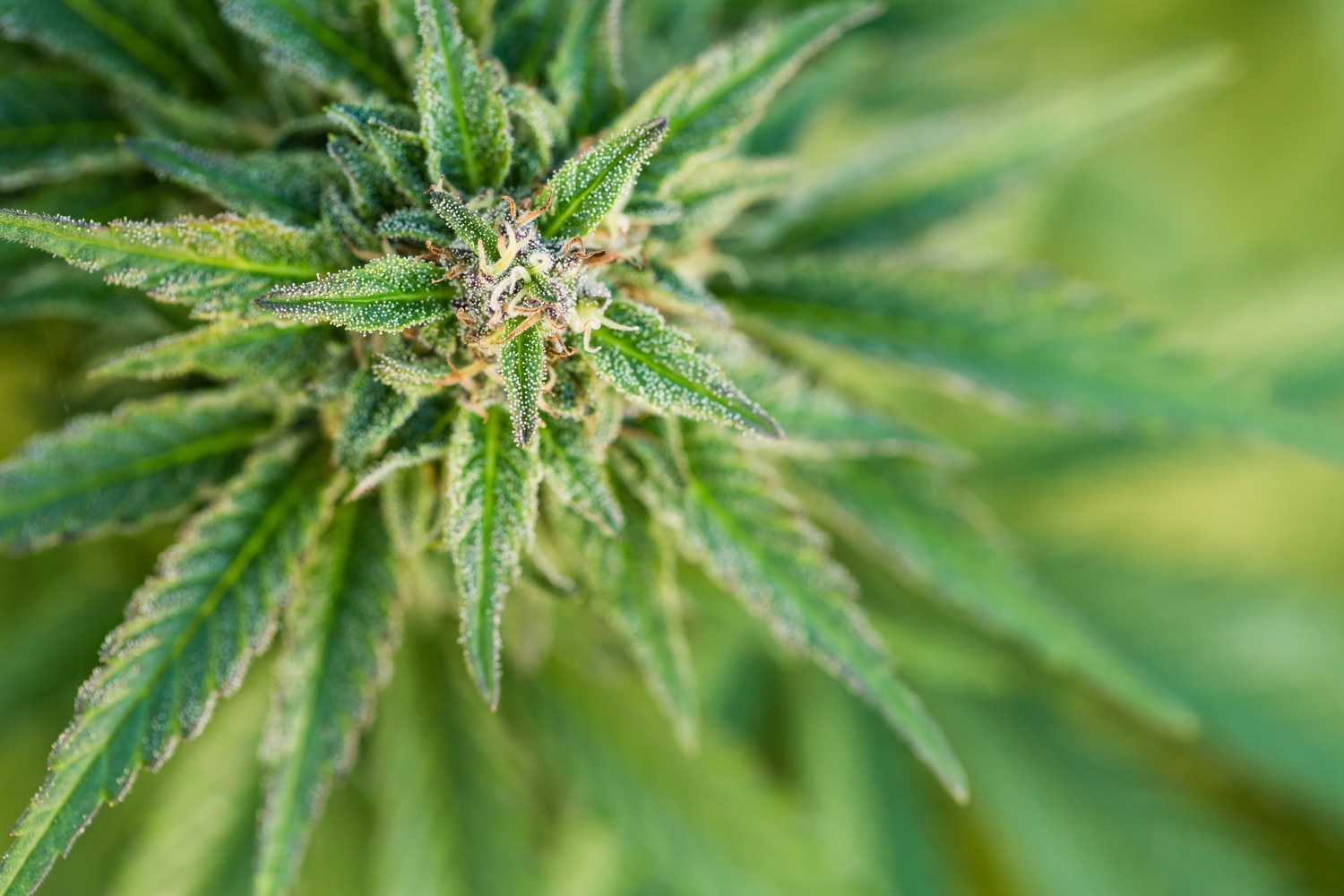If you’ve been in the CBD loop for a while, chances are you know about terpenes to some extent. These compounds found in broad-spectrum and full-spectrum CBD oil (and throughout the plant kingdom) are crucial for the best therapeutic results.
So what are terpenes? What role do cannabis terpenes play? How do they impact the quality of CBD products? Let’s look at these questions – and more – to see why natural cannabis terpenes aren’t just beneficial – they’re essential.
What are Terpenes?
A Quick Note on Cannabis
Before we discuss terpenes, we need to clear the air about cannabis and cannabinoids. “Hemp” and “cannabis” are often used to differentiate between low-THC and high-THC products. There’s no scientific basis for this difference. All forms of this plant, be it “hemp” or “marijuana,” refers to the cannabis Sativa L. plant species.
“Hemp” is a legal term for cannabis with less than 0.3% THC by dry weight, while “marijuana” (often referred to as “cannabis”) exceeds the 0.3% limit. Neither marijuana nor hemp is considered plant species in the field of botany.
The compounds in cannabis are identical, regardless of the cultivar they come from.
What are Terpenes?
Terpenes are naturally-occurring oily compounds found throughout the plant kingdom, including all cannabis strains. Known for giving plants and fruits their distinct aromas, terpenes may also have a variety of therapeutic properties. The terpenes found in cannabis are no different than those in their natural plant counterparts.
Many terpenes offer exclusive, unique effects, while others often overlap. While seemingly random, these effects “stack up” in a synergistic relationship between cannabinoids and terpenes that maximizes a CBD product’s benefits.
Whether ingested or smoked, the effects and benefits remain consistent. The only difference is that inhaled terpenes and cannabinoids take effect almost immediately, while ingestible CBD takes anywhere from 30 minutes to three hours.
Are Terpenes Bad for You?
No, terpenes aren’t bad for you – quite the contrary. After all, they exist in every plant, flower, and vegetable we grow or consume.
However, this isn’t the case for inhaled cannabis. Terpenes are a bit irritable and they don’t like heat. Consequently, vaping cannabis terpenes at temperatures above 401 F (205 C) causes terpenes to destabilize and become benzene, a known carcinogen.
Cannabis vape pens and CBD flower will burn well above that threshold. A temperature-controlled dry herb vape is the only way to smoke terpenes at lower temperatures.
Types of Terpenes
Different types of common terpenes are split into several categories based on their molecular structure.
The Nine Types of Terpenes
Terpenes are composed of several isoprene molecules or “units” (Jackson, 2008), which are composed of five carbon atoms with double bonds (two pairs of electrons mutually attached to two atoms).
The most “basic” terpenes, such as myrcene, linalool, and pinene, are considered “monoterpenes” because they contain only two isoprene units – the simplest structure of all terpenes. Below is the full list with some examples.
-
Monoterpenes (limonene, myrcene, pinene)
-
Hemiterpenes (isoprene, isoprenol)
-
Sesquiterpenes (humulene, farnesene)
-
Diterpenes (kahweol, cafestol)
-
Sesterterpenes (geranylfarnesol, leucosceptrine)
-
Sesquaterpenes (ferrugicadiol)
-
Triterpenes (squalene)
-
Polyterpenes (natural rubber)
-
Tetraterpenes (beta-carotene, lycopene)
You may not recognize some – if not most – of these names. That’s because not all of these terpenes exist in cannabis strains. But researchers have identified around 400 terpenes native to cannabis products. This number pales in comparison to the over 20,000 known terpenes throughout the plant kingdom.
However, only a handful have received extensive research into their therapeutic properties. If what we know so far is any indication, terpenes may be a breakthrough in personal wellness.
Terpenes vs. Terpenoids
Terpenes are also split into two categories, again based on molecular structure. All terpenes contain “functional groups.” Functional groups are groups of atoms that give a compound its specific effects.
Compounds containing only hydrogen and oxygen atoms are considered terpenes. Terpenoids, on the other hand, carry additional functional groups.
Why are Terpenes Important in Cannabis?
The terpenes found in plants are important for a variety of reasons. Different cannabis strains get their unique flavor, scents, and effects from specific, relatively consistent, cannabinoid and terpene profiles.
But there’s much more to the many different terpenes than flavor and effects, which we’ll cover next.
Role in Protecting the Cannabis Plant
 Potential predators, such as pests or hungry animals looking for food, constantly threaten plants – and cannabis is no exception. Plants use certain terpenes and terpenoids to help repel anything that may want to snack on its fruits, leaves, or flowers.
Potential predators, such as pests or hungry animals looking for food, constantly threaten plants – and cannabis is no exception. Plants use certain terpenes and terpenoids to help repel anything that may want to snack on its fruits, leaves, or flowers.
The smell or taste of certain terpenes reduces the chance of a cannabis harvest being damaged by animals and critters looking for a buffet. Here are a few examples (Boncan et al., 2020):
-
Ocimine
-
Terpinolene
-
Limonene
-
Caryophyllene
-
Humulene
-
Pinene
Attracting Pollinators
Another lesser-known role, many terpenes help attract pollinators, aiding natural plant reproduction.
Although pollinators can complicate things for outdoor breeders, terpenes found in cannabis strains are critical in the wild.
Pollination terpenes in cannabis include:
-
Ocimene
-
Farnesene
-
Myrcene
-
Linalool
-
Limonene
-
Pinene
As you can see, there’s some overlap between protective terpenes and pollination terpenes. But that’s what makes these oily compounds so amazing. They’re versatile, so terpenes may offer a variety of therapeutic effects. More on that next.
Terpene Benefits
Anti-Inflammatory
Many terpenes found in cannabis may have anti-inflammatory properties. It’s difficult to determine how effective they are, but strains high in certain terpenes may offer better anti-inflammatory benefits.
Pain relief
Pain is a major symptom people like to treat with THC and CBD. Based mostly on anecdotal evidence and preliminary research (which we’ll cover later), both major cannabinoids are reportedly able to relieve mild to moderate pain.
Sleep
People rely on cannabis extracts – such as CBD oil – to help relax and sedate them in the evenings. Again, these haven’t been examined in clinically-controlled, double-blind studies, but early and anecdotal evidence appears to support the use of CBD for sleep.
Epilepsy
Epilepsy is the only condition that actually received three double-blind, placebo-controlled studies, according to the FDA. The conclusions led to the approval of a CBD-derived pharmaceutical drug called Epidiolex.
However, these studies only covered two specific forms of severe childhood epilepsy. There’s no evidence to suggest that CBD helps with the many other types of epilepsy that are more common and less severe.
It’s also critical to note that CBD can interfere with certain epilepsy medications. We strongly recommend speaking to a doctor or specialist before trying CBD to treat seizures.
Appetite
Although some cannabis strains are more effective than others (again, due to the terpenes and cannabinoids involved), CBD appears to help some people with nausea or poor appetite.
Antibacterial
Certain terpenes may have antibacterial, antifungal, or antiviral properties. This can come in handy for internal (smoking, ingestion) or external (topical) use.
The Entourage Effect
The Entourage Effect is a synergistic relationship between cannabinoids, terpenes, and terpenoids. In other words, these compounds work together, building upon each others’ effects – more on that shortly.
What are the Benefits of Terpenes?
Cannabinoids and terpenes go together like peanut butter and jelly. While, unfortunately, we can’t cover the over 400 terpenes and terpenoids in cannabis flowers, there are a few major ones that received attention from researchers.
Most of these terpenes are believed to have multiple benefits. However, the list is too extensive to cover in detail. We’ll focus on one or two benefits in each, covering the symptoms mentioned earlier
Beta-Caryophyllene
Beta caryophyllene (or B-caryophyllene for short) is a unique terpene. Beta-caryophyllene is the first known “dietary cannabinoid.” No, that’s not a typo. Unlike other terpenes, caryophyllene binds to the CB2 cannabinoid receptors located in the peripheral nervous system, digestive system, immune system, and more. (Hartsel et al., 2016)
Caryophyllene hasn’t received much attention in human studies, but animal studies are plentiful (and the next best reference point we have).
One such study examined the potential pain-relieving properties of caryophyllene on rodents. injected beta-caryophyllene extract into one front paw, while leaving the other as a control reference. Researchers observed that the pain response in the animal subjects was milder in the test paw compared to the control limb. (Klauke et al., 2014)
The authors concluded that the mechanism of action is likely due to the CB2 receptors’ role in controlling pain and inflammation (among others issues).
Type: sesquiterpene
Aroma: spicy, peppery
Sources: black pepper, clove, basil, cinnamon
Effects: relaxation (without sedation)
Uses/Benefits: pain, inflammation
Linalool
Linalool is a rare terpene found in certain cannabis strains. Despite it popping up less frequently, linalool is famous for its ability to potentially help control seizures.
While this claim is far from proven, some studies point to a possible connection between linalool and antiepileptic effects.
One study examined linalool’s anticonvulsant effects in mice. The researchers stress the longstanding role between essential oils and their history of therapeutic use. They administered linalool at 200 – 300 mg/kg to laboratory mice before inducing seizures.
They found that mice who took the 300 mg dose showed a notable reduction in seizure duration. Ultimately, the researchers observed that linalool is comparatively effective to diazepam, an anti-seizure drug used to stop seizures in a medical emergency or for daily therapeutic use (Sousa et al., 2010).
Type: monoterpenoid
Aroma: wood, floral
Sources: lavender, coriander, basil
Effects: relaxation, sedation
Uses/Benefits: seizures, sleep, stress
Humulene
Consuming CBD or THC can spike appetite – especially with the latter. But the cannabis strain contains enough humulene, you’ll experience the opposite effect.
However, no research exists on how humulene can help with weight loss – if at all. But experts explored other areas and found some key benefits, most notably its unique (but not exclusive) antibacterial properties.
A 2020 study examined humulene’s effects on Bacteroides fragilis, a bacteria responsible for inflammatory bowel disease. When applied to a sample of the bacteria, the author noticed a reduction in B. fragilis biofilm and bacterial replication. These results indicate that humulene may help lighten or eliminate some infections (Jang et al., 2020).
This discovery is particularly important due to the increase in antibiotic-resistant bacteria, which poses a threat to modern medicine as we know it.
Type: sesquiterpene
Aroma: wood, spice, herbal
Sources: ginseng, hops, sage
Effects: reduced appetite, relaxation
Uses/Benefits: appetite control, antimicrobial
Limonene
Limonene is a terpene found in citrus fruits, among other sources. But while it’s known for its zesty, energizing aroma, Limone could also provide powerful anti-inflammatory benefits.
Inflammation is a common reason people turn to cannabis extracts like full-spectrum CBD oil, with many anecdotes and preliminary studies supporting its efficacy. If chronic swollen joints or other inflammatory symptoms are a problem, a hemp product rich in limonene may help.
One study looked at the anti-inflammatory effects of myrcene and limonene. Researchers tested the anti-inflammatory effects of both terpenes against osteoarthritis.
The experts grew human cartilage cells in a test tube, then applied both terpenes individually to each sample. They discovered that both myrcene and limonene inhibit nitric oxide production, an important molecule in signaling inflammatory responses.
With the nitric oxide muted, inflammation is less severe. But while limonene and myrcene both offered the same benefits, myrcene eventually was found to be marginally more effective (Rufino et al., 2015).
Type: monoterpene
Aroma: citrus
Sources: juniper, lemon
Effects: energizing, uplifting
Uses/Benefits: cleaners, food flavoring
Pinene
As its name implies, pinene is a terpene commonly found in pine trees, making it responsible for the familiar smell we often find in the deep forest.
But pinene may have some other benefits as well. Pinene has gained attention from mental health experts and neurologists due to its potential neuroprotective properties.
A 2021 review of existing literature examined existing studies on the neuroprotective benefits of both pinene and linalool (whose possible neuroprotective properties we already established).
The review included both animal and cell studies. The authors noticed several instances of potential brain health benefits.
For instance, the studies reviewed show that essential oils high in pinene had significant antioxidant benefits. Antioxidants play a critical role in developing and maintaining brain health and fighting neurodegeneration due to age or a gradually worsening illness like Alzheimer’s.
The review also mentions preliminary evidence that pinene can help stabilize mood by controlling anxiety and depression while also having potential anti-seizure effects. (Green et al, 2021).
Type: monoterpene
Aroma: pine
Sources: pine, rosemary, basil
Effects: calming
Uses/Benefits: household cleaner, food flavoring
List of Other Terpenes Found in Cannabis
Since there are over 400 terpenes native to cannabis, it’s impossible to list them all. Below are a few examples of cannabis terpenes you may not have heard of.
-
Ocimene
-
Eucalyptol
-
Farnesene
-
Bisabolol
-
Myrcene
-
Terpinolene
-
Guaiol
-
Nerolidol
-
Menthol
-
Terpinene
The Entourage Effect and How Terpenes Enhance CBD
The Entourage Effect is a synergistic relationship between cannabinoids and terpenes. When combined with CBD and other cannabinoids, terpenes build upon each other’s strengths, even changing our own cannabinoid receptors to create new effects and benefits.

For instance, CBD indirectly alters our CB1 receptors to counter THC intoxication. Meanwhile, terpenes and terpenoids add their own therapeutic effects – with potent results.
How Do Terpenes Work?
A study from 2009 published in the International Journal of Neuroscience found that the effects of terpenes can be explained by the pharmacological or psychological aspect, which is quite impressive. The pharmacological aspect found that terpenes can do what they do by directly interacting and affecting our nervous system, central nervous system, and endocrine systems. (Herz, 2009)
On the other hand, the psychological aspect argues that the reason behind what terpenes do is how “odors exert their effects through emotional learning, conscious perception, and belief/expectations” rather than direct interactions with systems in our body.
Pharmacological Process
There is plenty of research and studies on terpenes and how they interact with our bodies from the pharmacological aspect. In a 2001 review about the synergic activity among terpenes and flavonoids with cannabinoids, Russo and McPartland mention that terpenes (Russo et al., 2001):
-
Remodel G-proteins
-
Alter the pharmacokinetics of cannabinoids by altering the blood-brain barrier
-
An increasing bioavailability of cannabinoids
-
Acting on other receptors and neurotransmitters
-
Act as a serotonin uptake inhibitor
-
Enhance norepinephrine activity
-
Increase dopamine activity
-
Increase GABA production
Psychological Process
On top of the studies regarding terpenes interacting with our system, there is evidence suggesting that terpenes may enhance or alter based on the psychological process through smell.
A 2003 study among 15 subjects ranging from 18 to 34 years of age found that odors can produce mood states that modulate the pain intensity, pain unpleasantness, mood, and anxiety or calmness. This study compared how altering attention away from pain or mood compared to the smell of odor and how it affected pain and mood (Villemure et al., 2003). The study found that attention direction had no effect on mood and anxiety but altered both perceived pain intensity and unpleasantness. In comparison, a pleasant and unpleasant odor changed mood, anxiety, and pain unpleasantness ratings but did not significantly affect perceived pain intensity.

For example, someone who had a negative experience with cannabis might find that the odor of cannabis produces anxiety as they remember the negative experience, while someone who enjoys consuming cannabis associates it with fun.
They concluded that both the pharmacological and psychological aspects contribute to the effect of cannabis terpenes. There is good evidence showing that terpenes do have direct physiological effects on our internal systems. Still, there is evidence associating terpenes’ smell to alter our mood and state of mind positively or negatively. This is not to say that cannabis terpenes have no “real” effect on our body, but they might vary from person to person.
How Are Terpenes Different From Cannabinoids?
Terpenes are different from cannabinoids for two reasons. First, cannabinoids directly or indirectly bind to our endocannabinoid receptors. Terpenes don’t work like that, with caryophyllene being the only exception.
Second, while terpenes are found in all plants, only cannabis provides external cannabinoids (phytocannabinoids). So while the cannabis flower contains terpenes, other plants are barren of cannabinoids.
Both groups also have different molecular or chemical structures, which influence how they interact with our bodies.
How to Know if a CBD Product Contains Terpenes?
It’s safe to say broad-spectrum, and full-spectrum CBD oil is superior to pure CBD isolate. But Just because oil contains terpenes doesn’t mean they’re the right kind of terpenes. In most cases, these critical cannabis compounds are lost during extraction, forcing the majority of vendors to infuse their oils with botanical terpenes artificially.
To avoid falling into this trap, it’s important to know how to check if your CBD product contains terpenes.

Check Third-Party Lab Tests
Third-party lab tests are the most accurate, detailed, and reliable sources. Not only do they cover terpene content, but they also mention cannabinoids and the presence of dangerous solvents (if any).
The results should be easy to read, with simple percentages assigned to each compound. Here is an example of Colorado Botanicals terpene profile test on their hemp extract.

Read the Labels Carefully
Again, there’s a difference between a cannabis product that contains natural terpenes compared to botanical terpenes.
If you see “botanical terpenes” mentioned as a specific ingredient, you know right away that the product is artificially infused with terpenes.
Where to Buy CBD Oil with Terpenes?
Plenty of vendors offer CBD oil with terpenes. But comparatively, few are able to retain natural cannabis terpenes without artificial infusion.
Colorado Botanicals offers a long line of full-spectrum and broad-spectrum CBD products, including oils, gummies, capsules, and topicals.
What sets CoBo apart from most premium CBD vendors is their proprietary CO2 extraction process. Their technique allows them to preserve natural cannabis terpenes that are otherwise destroyed during conventional CO2 extraction.
Couple that with discounts for repeat orders, excellent prices, and a flexible return policy, and it’s clear Colorado Botanicals is the best place to try terpene-rich CBD, risk-free.
Conclusion: What are Terpenes?
On the surface, terpenes are just oily compounds found throughout the plant kingdom that give plants their unique aromas.
However, recent research suggests that there’s more to terpenes than a nice scent or flavor. These compounds could have substantial medical benefits. If given enough attention, researchers may one day make significant medical breakthroughs using substances that have been under our noses for millennia.
But until more conclusive information is available, the next best option is to be cautiously optimistic.
Sources
de Sousa, D. P., Nóbrega, F. F. F., Santos, C. C. M. P., & de Almeida, R. N. (2010). Anticonvulsant Activity of the Linalool Enantiomers and Racemate: Investigation of Chiral Influence. Natural Product Communications, 5(12), 1934578X1000501. https://doi.org/10.1177/
Herz, R. S. (2009). Aromatherapy facts and fictions: a scientific analysis of olfactory effects on mood, physiology and behavior. The International Journal of Neuroscience, 119(2), 263–290. https://doi.org/10.1080/
Jackson, R. S. (2008). Chemical Constituents of Grapes and Wine. Wine Science, 270–331. https://doi.org/10.1016/b978-
Jang, H.-I., Rhee, K.-J., & Eom, Y.-B. (2020). Antibacterial and antibiofilm effects of α-humulene against Bacteroides fragilis. Canadian Journal of Microbiology, 66(6), 389–399. https://doi.org/10.1139/cjm-
Klauke, A.-L. ., Racz, I., Pradier, B., Markert, A., Zimmer, A. M., Gertsch, J., & Zimmer, A. (2014). The cannabinoid CB2 receptor-selective phytocannabinoid beta-caryophyllene exerts analgesic effects in mouse models of inflammatory and neuropathic pain. European Neuropsychopharmacology: The Journal of the European College of Neuropsychopharmacology, 24(4), 608–620. https://doi.org/10.1016/j.
Rufino, A. T., Ribeiro, M., Sousa, C., Judas, F., Salgueiro, L., Cavaleiro, C., & Mendes, A. F. (2015). Evaluation of the anti-inflammatory, anti-catabolic and pro-anabolic effects of E-caryophyllene, myrcene and limonene in a cell model of osteoarthritis. European Journal of Pharmacology, 750, 141–150. https://doi.org/10.1016/j.
Weston-Green, K., Clunas, H., & Jimenez Naranjo, C. (2021). A Review of the Potential Use of Pinene and Linalool as Terpene-Based Medicines for Brain Health: Discovering Novel Therapeutics in the Flavours and Fragrances of Cannabis. Frontiers in Psychiatry, 12. https://doi.org/10.3389/fpsyt.
Wiart, C. (2014). Terpenes. Lead Compounds from Medicinal Plants for the Treatment of Neurodegenerative Diseases, 189–284. https://doi.org/10.1016/b978-










